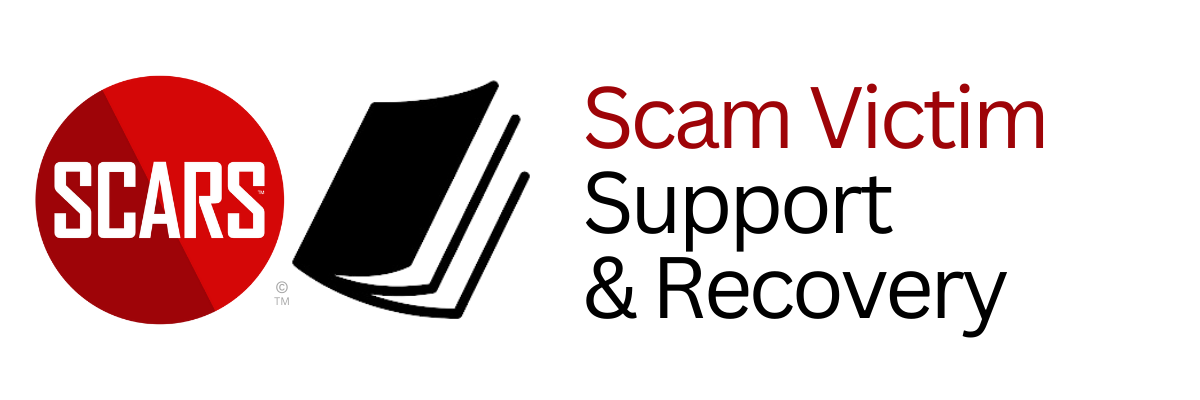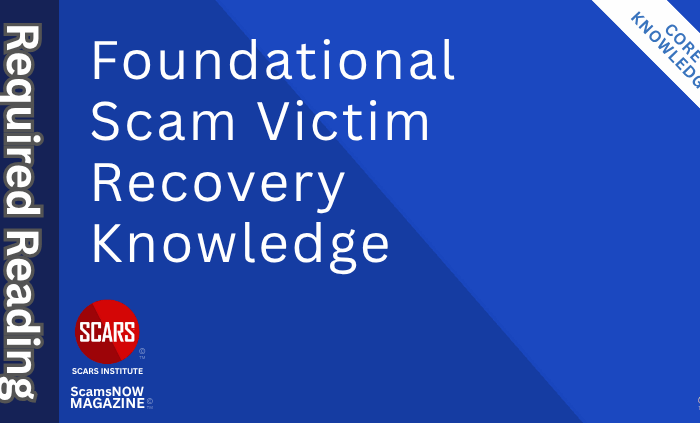
Scam Victim Trauma Denial and Why It Is So Difficult to Overcome
Reasons Scam Victims and Their Families May Deny Their Trauma
Primary Category: Scam Victim Recovery Psychology
Author:
• Vianey Gonzalez B.Sc(Psych) – Licensed Psychologist, Specialty in Crime Victim Trauma Therapy, Neuropsychologist, Certified Deception Professional, Psychology Advisory Panel & Director of the Society of Citizens Against Relationship Scams Inc.
• Tim McGuinness, Ph.D., DFin, MCPO, MAnth – Anthropologist, Scientist, Polymath, Director of the Society of Citizens Against Relationship Scams Inc.
About This Article
You faced a crime, not a personal failing, and denial appeared to protect you from shock, fear, and shame. You learned how the body’s alarm responses, cognitive dissonance, and sunk costs can keep you attached to a false story, and how family beliefs, image concerns, and myths about scams can push loved ones to minimize what happened. You now have practical tools to move through denial with care and accuracy. You stabilize your body, write a plain one-paragraph account, and organize a facts folder. You verify events with neutral records, set clear boundaries, and use short scripts that keep conversations respectful and focused. You choose trauma-aware support, make micro commitments, report when appropriate, and harden accounts to lower risk. Most importantly, you rebuild identity through values-based actions and small wins. Progress becomes steady and real when you pair compassion with facts and take one clear step at a time.
Note: This article is intended for informational purposes and does not replace professional medical advice. If you are experiencing distress, please consult a qualified mental health professional.

Reasons Scam Victims and Their Families May Deny Their Trauma
Please note: If you are a new or recent scam victim, please visit www.ScamVictimsSupport.org for the overall information you need first.
You faced a real crime. A scammer used deception, pressure, and manipulation to take something valuable from you. That harm does not define your intelligence, your character, or your worth. You did not invite the abuse. You did not deserve it. The shock you feel comes from being targeted and harmed, not from weakness. When you keep that truth in view, you take shame out of the driver’s seat and you give yourself room to heal.
Denial often appears after a scam because your mind and body try to keep you safe when everything feels too much. Denial works like a shield. It helps you slow the impact of the loss, the fear, the anger, and the grief. You might hear yourself say it could not have been that bad, or that the person meant well, or that the money will come back soon. You might minimize what happened or avoid looking at messages, receipts, or bank statements. These reactions can appear for a short time while you regain balance. They are common in people who experience trauma and sudden change. They are not a permanent solution. They delay relief and keep you stuck with the weight of what happened.
This guide helps you understand why denial shows up in you and in your family. You will see how stress responses, identity threats, and money stigma feed denial. You will learn how family beliefs, conflict avoidance, and fear of judgment lead loved ones to dismiss or minimize your experience. Most importantly, you will learn respectful ways to move through denial without attacking yourself or others. You will use clear language, small steps, and steady routines to regain stability. You will create healthy boundaries, choose helpful support, and build a plan that protects your time, your finances, and your peace.
The Psychology of Denial After a Scam: A Plain-Language Overview
Denial works as a short-term shield when a scam ends and the truth feels unbearable. Your mind tries to protect you from shock, fear, and shame by softening the facts. You might tell yourself it is not as bad as it looks, or that a refund will arrive any day, or that the person who lied to you had good intentions. This shield reduces pain in the moment. It helps you breathe and keep moving when everything feels heavy. Denial is common and understandable. It is not a defect in your character. It becomes a problem only when it stays in place and blocks the steps that restore your safety and peace.
Avoidance is the most visible part of denial. You skip looking at statements, delay opening messages, or stop talking about the loss. You keep busy to distract yourself. Avoidance reduces anxiety for a short time, which trains your brain to use it again. The cost arrives later. Bills go unpaid, evidence disappears, and stress grows in the background. You break this loop by taking small, time-limited actions. You set a five-minute timer, open one document, or read one message. You finish a tiny task and stop. Small wins rebuild a sense of control without overwhelming you.
Cognitive dissonance also keeps denial in motion. You hold two facts that conflict. You believed you were in a real relationship or a sound investment. You now see signs of deception. That clash feels painful. To reduce the discomfort, you may reject the new information or rewrite the story. You might say the account was hacked or that a delay explains everything. You defuse this pressure by stating both facts in plain language. You say what you believed. You say what happened. You sit with the discomfort for a short time, then choose one small step that fits the evidence.
Confirmation habits add another layer. Your mind searches for details that support your original belief and filters out the rest. You re-read the kind messages but skip the requests for secrecy or urgency. You look for testimonials but ignore warnings. You interrupt this habit by using neutral checks. You review dates, amounts, and actions. You compare claims with bank records or platform logs. You ask a trusted person to read the timeline without offering opinions. Facts that match across sources move you forward. Facts that do not match signal caution.
Dissociation can also appear. You feel foggy, numb, or detached. Time blurs and memories break into fragments. This is a stress response, not a sign that you are failing. You reduce dissociation by grounding your body. You name five things you see. You feel your feet on the floor. You breathe slowly, count to four, and exhale to six. You write brief notes to anchor details while they are fresh. These simple steps help your thinking return when emotions surge.
Your body’s threat systems drive many of these reactions. The alarm shows up as fight, flight, or freeze. You argue, you run from hard tasks, or you shut down. None of these states last forever. You soothe the alarm with routine. You sleep, hydrate, eat simple meals, and move your body. You plan your day in short blocks. You keep a calm, factual tone when you talk about what happened. When your body feels safer, your mind can accept facts without sliding back into denial.
You can treat denial as information. It tells you that the load feels heavy right now. With steady care, accurate facts, and small actions, you lower the load and open a path to recovery.
Why You May Deny Your Trauma (Primary Victim/Survivor)
After a scam, denial can feel like the only way to keep breathing. You try to hold life together while your mind shields you from shock, fear, and shame. This section helps you understand why denial shows up in you and how it keeps its grip. You will look at the body’s freeze response, the pull of shame and money stigma, and the way a shaken identity resists new facts. You will see how cognitive dissonance and sunk costs keep the old story alive, how hope turns into a protective fantasy, and how memory gaps or numbness make the details hard to face. You will consider fears about social, work, legal, and family fallout, the pain of moral injury and self-blame, and the influence of cultural, religious, and generational messages. By naming these patterns in plain language, you will reduce confusion and reclaim the steady steps that restore safety, dignity, and self-trust.
Shock, Overwhelm, and the Freeze Response
When the scam comes to light, your nervous system reacts before your thinking mind can process the facts. Your heart rate may spike, your breath may shorten, and your muscles may tense. This alarm state often brings a freeze response. You feel numb, detached, or stunned, as if events are happening behind glass. Disbelief is part of this reaction. Your mind slows the impact so you can function. You may say it cannot be true or that it must be a misunderstanding. This is not weakness. It is a protective reflex. As your body calms through rest, hydration, and steady routines, clarity returns. Denial loses strength when you feel physically safer and better able to handle what you see.
Shame, Financial Stigma, and Fear of Judgment
Shame tells you to hide. Money loss can feel like proof of failure, even though the crime rests with the offender. You may worry that friends or coworkers will see you as gullible. You may fear that family will blame you for the financial impact. This pressure leads to silence, delay, and downplaying the facts. You break the cycle by using accurate language. You say you were targeted by a crime. You name tactics like lies, secrecy, and urgency. You share only what is needed with people who will treat you with respect. Each honest sentence weakens shame and makes space for practical steps.
Identity Threat and Loss of Self-Concept
A scam strikes at how you see yourself. You may value being competent, careful, and kind. The discovery shakes those qualities. You might ask how this could happen to someone like you. You might feel distrust toward your own judgment. Denial tries to hold your old identity in place by rejecting the new information. You rebuild by separating your values from the crime. Your competence returns as you organize facts. Your care for others continues as you care for yourself. Your judgment strengthens as you learn patterns of deception and practice safer habits.
Cognitive Dissonance and Sunk-Cost Thinking
You believed a relationship was real or an offer was sound. New facts contradict that belief. The clash between what you hoped and what happened produces tension. To reduce that pressure, your mind may ignore the new data or reinterpret it to fit the old story. Sunk-cost thinking adds to this. You invested time, trust, and money, so your mind defends those investments by insisting the outcome will improve. You counter both forces by writing a clear timeline. You compare messages, amounts, and dates. You allow the discomfort, then choose one action that reflects the evidence, such as freezing an account or blocking contact.
Hope and Protective Fantasy
Hope keeps people going, yet it can also bind you to a false promise. You may hold to the belief that it will still work out, that a transfer will arrive, or that the person will return and explain everything. This fantasy softens pain in the short term. It also postpones protection. You keep hope where it helps by redirecting it. You place hope in your ability to recover, to learn, and to set limits. You write one hopeful sentence about your future that does not depend on the offender.
Memory Gaps, Dissociation, and Emotional Numbing
Stress can fragment memory. You may lose track of order, blur dates, or forget key details. Dissociation can make you feel distant from your thoughts, as if you are watching a movie of your life. Emotional numbing reduces the sting but also reduces clarity. Denial finds room to grow in that fog. You restore clarity by grounding your senses and capturing facts while they are fresh. You write short notes after each call or message. You keep copies of statements and screenshots in a single folder. You speak dates and amounts out loud to anchor them. As memory organizes, denial gives way to a clearer picture.
Fear of Consequences: Social, Work, Legal, and Family
You may worry about what happens if you tell the truth. You may fear that friends will judge you, that work will question your competence, or that legal steps will be stressful and public. You may worry that family will fight about money or blame you for losses. These fears push you toward silence, which protects you in the moment but exposes you to more risk. You reduce fear by planning disclosures. You decide who needs to know and what they need to hear. You set time limits for hard talks. You consult a qualified adviser about reporting and account protection. Each planned action lowers risk without inviting chaos.
Moral Injury and Self-Blame
You likely hold values about honesty, loyalty, and responsibility. The scam forced you into choices that now feel out of line with those values. You may feel you failed yourself or harmed people you love. This pain is moral injury. Denial tries to mute it by insisting nothing serious happened. Healing begins when you name the injury and place responsibility where it belongs. You acknowledge the harm and the deception that produced it. You make amends where needed through honest steps, not through punishment of yourself. You restore trust in yourself by aligning your next actions with your values.
Cultural, Religious, and Generational Messages
Upbringing shapes how you respond to loss. You may have learned that strong people do not talk about money or pain. You may have absorbed messages that faith, optimism, or hard work will always fix problems quickly. You may come from a family or culture that links worth to financial success or that treats victimization as a personal flaw. These messages can push you to deny or minimize harm. You respect your heritage while choosing truth. You keep the parts that give you strength, such as perseverance and care for others. You set aside the parts that silence you. You tell a balanced story that includes both resilience and accurate facts.
Bringing these patterns into the light reduces their power. Denial is a signal that you are carrying more than your system can process in one step. You move forward by supporting your body, stating facts clearly, and choosing small actions that protect your money, your time, and your peace. Each step confirms that you can face the truth and build stability without losing yourself.
Why Families May Deny or Minimize Your Trauma
When a scam harms you, family members may struggle to face what happened because it threatens how they see themselves and the people they love. You may meet silence, quick reassurance, or arguments that shift attention away from the facts. These reactions often come from fear, guilt, money stress, or learned beliefs about strength and pride. Denial can help a family feel steady in the short term, yet it leaves you without the understanding and support you need. In this section, you will see why family members protect a shared image of we are fine, how myths about scams and blame take hold, and why control, loyalty, and secrecy keep the truth out of sight. You will learn practical ways to keep conversations clear, protect your safety, and set limits while you hold to facts and respect.
Threat to Family Identity and Public Image
Families often carry a shared story that says we are fine. That story offers stability, pride, and a sense of safety. When a scam occurs, the event challenges that shared identity. Loved ones may fear that admitting the truth will stain the family’s image in the community or invite judgment from friends, coworkers, or extended relatives. Denial appears as a quick fix. A parent or partner may downplay the facts, change the subject, or insist it was only a misunderstanding. This protects the surface picture of harmony but leaves you alone with the weight of what happened. You reduce the hold of this pattern by stating simple facts without drama. You name the crime and its effects. You do not ask for permission to feel what you feel. A calm, clear tone keeps the focus on reality rather than on appearances.
Avoiding Guilt, Responsibility, and Hard Conversations
When people love you, they may feel guilty that they did not see the danger or protect you sooner. That guilt can feel heavy and confusing. To avoid it, family members may resist conversations, deny the extent of the loss, or suggest that you move on. Some may worry that they advised you in ways that now look unwise, so they defend their past advice instead of facing the outcome with you. Others fear conflict and shut down at the first sign of strong emotion. These reactions make sense as self-protection, yet they block connection. You keep the door open by setting clear goals for each talk. You ask for one thing at a time, such as quiet listening or help with a single task. You keep discussions brief and specific. When someone lapses into blame or avoidance, you pause and return to the plan later.
Financial Stress, Conflict Avoidance, and Control
Money pressure can drive minimization. A family that already feels stretched may fear that full honesty will force changes that feel hard, such as cutting expenses, seeking legal help, or restructuring debts. To keep routines intact, members may suggest that the loss is small or temporary. A controlling person may insist on handling everything in private, which silences you and hides the facts. Conflict-avoidant people may offer vague reassurance rather than concrete support. You counter these patterns with practical steps. You separate immediate needs from long-term repairs. You list three actions that reduce risk, such as freezing accounts, changing passwords, and tracking transactions. You assign tasks based on skills, not on status or emotion. Clarity turns arguments into decisions and moves the family from panic to problem-solving.
Myths About Scams and Victim Blame
False beliefs make denial stronger. Common myths claim that only careless or lonely people get scammed, that alert adults would always notice a con, or that financial loss proves poor character. These myths shift a criminal act onto your shoulders. Loved ones who hold these beliefs may protect their own sense of safety by deciding that what happened to you could not happen to them. You do not need to debate these myths point by point. You can replace them with accurate statements. Scams target smart, capable people through sophisticated tactics. Offenders study human behavior and exploit trust, love, fear, and urgency. A crime is a crime even when the method is emotional or digital. Clear facts reduce the power of blame and open space for compassion.
Indirect Trauma Responses: Minimizing, Deflecting, and Gaslighting
Families use defense habits when they feel threatened. Minimizing sounds like it was not that much or everyone makes mistakes. Deflecting shifts attention to your tone or timing rather than the facts. Gaslighting denies your memory or questions your judgment, which makes you doubt your own experience. These habits often grow from fear, not from malice, yet they still harm you. You respond by anchoring the conversation in verifiable details. You reference dates, amounts, and messages. You say what you saw and what you did. You avoid debating motives. If a talk becomes circular, you end it and return later with a written summary. You invite participation that is specific, such as helping gather statements or sitting with you while you make a call. Specific actions reduce defensive talk.
Loyalty Conflicts and Boundary Problems
Loyalty can keep denial in place. A relative may know the offender or feel loyal to an image of the family that does not include public setbacks. Secrecy feels like loyalty, so people hide information or discourage you from seeking help. Boundaries blur when others claim the right to decide what you share, who you tell, and when you act. You protect yourself by stating your rights plainly. You decide what to disclose to authorities or advisers. You decide how you tell your story to trusted people. You respect private details that are not yours to share, while you refuse to bury facts that affect your safety or finances. Healthy loyalty supports truth. It does not silence it.
Secondary Gain From Minimization
Some family members benefit when nothing changes. Denial preserves routines, roles, and comfort. A person who prefers control may keep decision power if the harm stays hidden. A person who fears work may avoid new tasks if the family pretends there is no problem. Recognizing this does not require anger. It requires clarity. You match support to behavior, not to promises. You invite help on clear tasks and set limits when others block progress. You invest your time in relationships that respect your safety and your recovery. As you act on facts, you shift the family system toward honesty, whether or not every member chooses to join you.
You cannot force others to face what they are not ready to face. You can choose truth, steady steps, and respectful limits. As you hold a clear line, denial loses ground. Your stability grows, and your example shows that care and facts can live in the same room.
Risks of Denial for Safety, Health, and Recovery
Denial can feel like relief in the moment, yet it quietly increases your risk. When you avoid the facts, you delay reporting, you postpone protections, and you carry stress for longer than your system can handle. Time matters after a scam. Banks, card issuers, platforms, and some agencies have short windows for disputes or holds. If you wait, you close doors that could have limited the loss. Denial also slows simple steps that reduce exposure, such as changing passwords, updating security settings, or freezing credit. The result is a longer period of uncertainty, more worry, and a heavier emotional load.
Delay also keeps you exposed to the offender. Many scammers test whether a victim will respond again. If you do not block contact or change credentials, they can reach you, reuse access, or pass your details to other criminals. Recovery scams target people who are still hoping for a fix. They promise to retrieve funds for a fee, then take more. If you do not act, you remain on those lists. Denial gives offenders time to probe your accounts, your devices, and your social circles. Quick, simple actions, even very small ones, reduce that window.
Financial harm often grows when you do not address it early. Unchanged passwords and weak authentication leave accounts vulnerable. Unreported theft invites more attempts. If your identity data was exposed, criminals can open accounts, create new phone lines, or intercept codes. Friends and family may be targeted through your compromised contacts. Each day without action gives scammers more room to work. You counter this by securing what you control. You enable two-factor authentication, change passwords with a manager, review bank and platform activity, and set alerts. You freeze credit with the bureaus when needed. You remove saved payment methods from platforms you no longer use.
Ongoing denial strains your health. Uncertainty feeds anxiety, sleep problems, and intrusive thoughts. You may stop social contact to avoid questions, which deepens isolation. Shame can pull you away from helpful routines like exercise, regular meals, and medical care. Over time, this pattern can lead to low mood, loss of energy, irritability, and difficulty concentrating. Your body stays in a stress posture, which makes decision-making harder and recovery slower. When you name what happened and take small, steady steps, your alarm lowers and your capacity returns.
You can replace denial with measured action. You report to your bank or platform, even if you think the window may have closed. You place fraud alerts and, if needed, freeze credit. You update passwords and remove unused connections. You run antivirus and device updates. You collect dates, amounts, and messages in one folder. You tell one trusted person what you are doing and ask for specific help, such as sitting with you during a call. Each concrete step reduces risk, shortens distress, and supports a clear path forward.
Evidence-Based Ways to Work Through Denial Gently
When denial shows up, you do not need force. You need steady care, clear facts, and small actions that reduce overload. You will move from avoidance to measured steps that protect your safety, organize your mind, and repair trust in yourself. Each practice below is simple, specific, and repeatable. You will choose one step at a time, keep sessions short, and build momentum through small wins. You will pair compassion with accuracy so you can face the truth without losing hope.
Stabilize Your Body and Daily Structure
Your body sets the tone for your mind. You breathe in for four, out for six, five times to lower the alarm. You keep a simple routine: wake time, meals, movement, and lights out at a consistent hour. You drink water, choose protein and fiber at each meal, and take a short walk or gentle stretch daily. You limit stimulants late in the day. You schedule one brief task block in the morning and one in the afternoon. A calm body makes clear thinking possible.
Name What Happened in Plain Language
You write a one-paragraph account that includes dates, amounts, platforms, and key actions. You keep it factual and short. You read it out loud once to hear the sequence. You update it only when new facts appear. This paragraph becomes your anchor during calls, reports, and conversations. It protects you from arguments about feelings by returning to verifiable events. Plain language reduces confusion and keeps your efforts aligned with reality.
Externalize the Crime, Reduce Shame
You separate your worth from the offender’s tactics. You write one sentence that names the crime and one sentence that names your value. For example, A criminal used deception to take my money and trust. I remain a capable person who is taking careful steps now. You repeat these lines before hard tasks. You remind yourself that manipulation targeted normal human strengths like trust and care. This stance lowers shame and frees energy for protection and recovery.
Build a Facts Folder
You create one private folder, digital or paper. You file your summary paragraph, a simple timeline, bank statements, screenshots, messages, and any case numbers. You title items by date and source so you can find them quickly. You add a short index page that lists what is inside. This folder turns scattered stress into organized information. It supports reporting, reduces repeated explanations, and helps you notice patterns that guide your next steps.
Verify With Neutral Tools
You confirm events with records that do not rely on memory. You check bank and card statements, platform logs, and message metadata. If cryptocurrency is involved, you use a reputable blockchain explorer to verify transactions. You compare amounts and timestamps across sources. When details match, you move forward. When they do not, you pause and seek clarification. Neutral tools cut through debate and keep decisions grounded.
Practice Compassionate Self-Talk
You replace harsh blame with accurate responsibility and care. You speak to yourself as you would to a trusted friend. You say, I am facing facts and taking steps to protect myself. You thank yourself for each small action completed. When criticism rises, you name one lesson and one next step. Compassion quiets the alarm, supports focus, and makes sustained effort possible.
Boundaries and Safe Conversations
You decide who is safe to tell and what each person needs to know. You set limits with anyone who dismisses, mocks, or pressures you. You say, I am not discussing blame. I am working from records and next steps. You time-box hard talks and end them if they drift into arguments. You share specific requests, such as a ride to the bank or help organizing statements. Boundaries protect energy and keep progress moving.
Scripts for Family Dialogues
You keep language clear, calm, and firm. You can say, A scam occurred. On [date] I transferred [amount] through [platform]. I have records and I am taking steps to secure accounts. If pushed to minimize, you say, I hear you. I am working with facts, not opinions. If someone blames you, you say, A crime occurred. I am focused on protection and recovery. I am open to help with specific tasks. You close with, Here is one way you can support me today. Scripts keep talks short and productive.
Choose Support Wisely
You select helpers who respect facts, privacy, and pace. You look for trauma-aware professionals and structured peer spaces that discourage shaming and speculation. You avoid groups that promise quick fixes or demand emotional exposure without safeguards. You set goals for each session and measure whether the support moves you toward safety, clarity, and stability. Good support reduces noise and increases effective action.
Decision Checkpoints and Micro-Commitments
You break work into the smallest possible steps. You set a five to ten minute timer and complete one action, such as downloading a statement or changing one password. You then pause and breathe. You mark the step as done. You use checkpoints to decide what comes next: Is this safe, necessary, and supported by records? Micro-commitments build confidence and keep you out of overwhelm.
Reporting and Practical Protections
You act on what you control. You change passwords using a manager, enable two-factor authentication, and review recovery emails and phone numbers. You freeze or monitor credit if identity data is at risk. You contact banks or platforms to report transactions and ask about holds or investigations. You document every call with date, time, and reference numbers. You block the offender on all channels. These steps reduce exposure and create a clear trail.
Rebuild Identity and Confidence
You reclaim who you are through values-based action. You list three values, such as honesty, care, and diligence. You choose one small act for each value this week, like sharing accurate information with a helper, taking a supportive walk with a friend, or finishing a review of one account. You track wins in a simple log. You acknowledge progress, no matter how small. Confidence grows when actions match values and results accumulate.
You do not need to solve everything at once. You need a calm body, clear facts, and one step at a time. As you practice these skills, denial loosens. Your safety improves. Your voice strengthens. You see yourself not as broken, but as a person who faced a crime and chose steady, respectful recovery.
Conversation Guides With Family and Friends
Before the talk, prepare your goal and no more than three key points. You decide what you want from this conversation, such as quiet listening, help with a task, or respect for a boundary. You write a one-paragraph summary with dates and amounts to keep the focus on facts. You choose a calm setting and set a clear time limit. You bring your notes so you do not have to rely on memory. You plan one request that the other person can fulfill today. You also plan how you will end the talk if it becomes dismissive or hostile.
During the talk, stay factual and time-box the conversation. You open with your goal and your time limit. You read your summary and pause. You invite one or two clarifying questions, not a debate. You redirect if the discussion drifts into blame, speculation, or arguments about your tone. You keep your voice calm and steady. You avoid defending your worth. You return to dates, amounts, and actions when emotions rise. You do not try to win. You try to be clear, brief, and respectful while protecting your energy.
After the talk, document any agreements and set next steps. You send a short summary by message or email that lists what was said and what will be done. You include deadlines and who will handle each task. If the other person dismisses you or refuses to respect your boundaries, you step back. You reduce the frequency and intensity of contact. You share less information. You invest your time in people who support your safety and recovery. You keep your records for future conversations so you do not have to repeat the same work.
Use short model lines that are respectful and direct. You can start with, “I want to share a clear account of what happened and what I need today. This will take fifteen minutes.” You can set the tone with, “A crime occurred. On [date], I transferred [amount] through [platform]. I have records. I am taking steps to secure accounts.” You can set limits with, “I will not debate my feelings or my character. I am working with facts and next steps.” You can redirect with, “I hear your view. Right now I need help with this specific task.” You can shut down blame with, “Blame does not help. Protection and recovery do. I am focusing on those.” You can close with, “Thank you for listening. Here is one way you can support me today.”
If the person continues to minimize, you use a firm close: “This conversation is not respectful. I am ending it now. We can try again when we can stay with the facts.” If the person responds with care, you acknowledge it: “I appreciate your support. It makes these next steps easier.” Each clear sentence keeps you in charge of your story, your safety, and your time. A calm plan, a short script, and steady boundaries turn hard talks into useful ones.
When Denial Persists in Others: Your Options
When someone refuses to face what happened, you do not have to pause your recovery. You can adjust closeness, choose where to share information, and keep moving with a steady plan. You protect your safety and peace even if others remain stuck. You do not punish or persuade. You act with clarity and care.
You calibrate closeness and information sharing. You decide who gets updates, how often, and in what form. You keep a short list of people who receive facts, such as dates, amounts, and the status of accounts. You keep a second list for emotional support, where you share feelings and stress. You reduce contact with anyone who minimizes, blames, or stirs conflict. You shorten visits, change topics, or end calls when they drift into disrespect. You can say, “I am not discussing blame. I am sharing the steps I am taking.” You can also say, “I will try again later when we can stay with the facts.” You give only the information that serves your safety and your goals.
You build a supportive circle outside resistant relationships. You look for trauma-aware helpers who respect privacy, pace, and clear boundaries. You choose one or two trusted people who listen without judgment and keep your information secure. You prefer structured peer spaces or professionals who understand betrayal trauma and financial harm. You set goals for support, such as one practical task per session or one planned check-in per week. You ask for specific help, not vague comfort. You can say, “Please sit with me while I call the bank.” You can say, “I need help organizing these statements for twenty minutes.” Specific requests turn care into progress and keep conversations focused.
You protect finances, data, and time even when others refuse the truth. You change passwords with a manager, enable two-factor authentication, and review recovery emails and phone numbers. You remove shared payment methods that no longer serve you. You set alerts on accounts and freeze credit when needed. You back up devices, update software, and run antivirus scans. You reduce exposure on social platforms by locking privacy settings and limiting who can contact you. You track calls and messages from unknown numbers and block contact from the offender and any new accounts they may use. You treat your time as a protected resource. You plan short task blocks and avoid long, draining talks that do not lead to action. Each protective step lowers risk, whether or not anyone else agrees that there is a problem.
You reaffirm your recovery plan regardless of family approval. You write a simple plan with three parts: what happened, what you are doing now, and what comes next. You review it weekly and record small wins, such as a password change, a call made, or a document filed. You keep decisions aligned with records and values rather than with pressure from others. You can say, “I am following a plan based on facts and safety. I will continue even if you disagree.” You can say, “I welcome help with specific tasks. I am not debating whether the harm is real.” This stance is firm and calm. It protects your momentum without inviting fights.
You use distance when needed. If a person continues to mock or undermine you, you step back. You reduce frequency of contact and choose neutral settings for any necessary exchanges. You stop giving updates that get twisted or used against you. You invest your energy where it returns support. You remember that you do not owe constant explanations. You owe yourself safety, stability, and a path that leads out of harm.
You keep compassion without sacrificing truth. Denial in others often reflects fear, guilt, or a fragile self-image. You can acknowledge that without taking on their avoidance. You can say, “I understand this is hard to hear. I am acting to protect my health and finances.” You can keep your tone steady and your steps small. You can offer a clear way to help and accept a no without engaging in argument.
You measure progress by your actions, not by their acceptance. You secure accounts, organize records, and complete one small step each day. You choose listeners who respect your boundaries. You update your plan and celebrate small gains. Over time, your calm consistency speaks louder than any debate. You move forward even if others stand still.
Conclusion – A Positive Path Forward
You now understand why denial rises after a scam and how it tries to shield you from shock, fear, and shame. You saw how the body’s alarm systems, identity threats, and money stigma pull you toward avoidance. You learned how family beliefs and myths about scams can lead others to minimize what happened. You also learned practical ways to move through denial without attacking yourself or anyone else. You can stabilize your body, name events in plain language, organize facts, set boundaries, and choose support that respects privacy and pace. You can keep your actions small and steady so you reduce risk and rebuild trust in yourself.
Your willingness to look at the truth is an act of courage. You chose clarity over confusion and action over silence. You faced a crime. You are not defined by what a criminal did. You are defined by the steps you take to protect your safety, your finances, and your peace. Each time you verify a detail, change a password, or set a boundary, you confirm that your judgment is working. Each small win restores confidence and widens the path ahead.
Use a short action checklist to turn insight into movement. Today, choose one protective step that you can complete in ten minutes. You can update a password with a manager, set an account alert, or gather two bank statements into your facts folder. This week, complete one reporting or documentation task. You can call a bank, place a fraud alert, or write a one paragraph summary with dates and amounts. This month, strengthen one supportive relationship and one routine. You can schedule a check in with a trauma aware helper and set a weekly plan for sleep, meals, and movement. These steps are simple, specific, and repeatable. They build momentum without overwhelm.
Hold on to hope that is grounded in facts. Progress may be steady and real when you pair care with accurate records and measured actions. You will not fix everything at once, and you do not need to. You only need the next right step. You will keep your focus on what you control, give yourself time to breathe, and choose practices that make you safer and stronger. With each step, denial loosens. Your energy returns. Your identity shifts from hurt and doubt to honesty and capability. You stand on a clear foundation, and you move forward with respect for yourself and for the truth you now hold.
Please note: If you are a new or recent scam victim, please visit www.ScamVictimsSupport.org for the overall information you need first.
Reference
After a scam, you do better when you have clear tools you can use right away. This set of practical aids helps you spot denial, capture the facts, hold respectful boundaries, and harden accounts. You will keep each item simple and repeatable so you can return to it as often as needed.
Quick denial indicators checklist
Use this as a fast scan when you feel stuck or uncertain.
-
- Language signs: you hear yourself say “It cannot be that bad,” “I will check later,” “They meant well,” “The money will come back.”
- Thought loops: you replay the kind messages but skip requests for secrecy or urgency, you search for one detail that restores the old story, you avoid timelines.
- Avoidance behaviors: you delay opening statements, ignore app alerts, scroll or clean to distract, cancel calls with the bank or platform.
- Emotional signals: you feel numb or foggy, you feel a sudden calm that collapses when you see evidence, you swing between hope and dread.
- Memory gaps: dates blur, amounts shift, you cannot recall who asked for what, you forget passwords you use often.
- Body cues: tight chest, shallow breathing, clenched jaw, headaches after any attempt to review records.
- Social patterns: you change the subject when asked, you laugh off losses, you tell different versions to different people.
- Logic traps: you say “I already put in so much,” you claim a delay explains everything without proof, you treat one friendly act as proof of honesty.
- Time slippage: hours pass without action, you promise to act tomorrow, yet you repeat the same routine.
When three or more items appear or apply to you, pause, ground your body, and take one protective step from your plan.
Sample one-paragraph incident summary template
Write this in plain language and keep it to five or six sentences. Read it aloud once before calls or reports.
On [date or range], I interacted with [name or handle] through [platform or app]. I was told [brief claim or promise]. On [dates], I sent [amounts and methods]. I later found [proof of deception or failed withdrawal]. I have records that include [statements, screenshots, messages]. I am securing accounts and requesting assistance to prevent further loss.
You can add one line for any reference numbers once they exist.
Short boundary script set
Use clear, calm sentences. Keep your tone steady and your request specific.
-
- Opening facts: “A crime occurred. On [date], I sent [amount] through [platform]. I have records and I am securing accounts.”
- Time-box: “I need fifteen minutes to share the facts and one request.”
- Stay on topic: “I will not debate my feelings. I am working with records and next steps.”
- Redirect blame: “Blame does not improve safety. Help with this task will.”
- Ask for help: “Please sit with me while I call the bank,” or “Please scan these statements into my folder.”
- End a circular talk: “This is not respectful. I am ending the conversation now. We can try again when we stay with the facts.”
- Appreciation: “Thank you for listening and helping with this step.”
Personal safety and account-hardening checklist
Work through these items in short sessions and mark progress as you go.
-
- Passwords: move to a password manager, change high-risk passwords first, use unique 16+ character passwords for email, bank, and phone carrier.
- Two-factor and passkeys: enable two-factor on all financial and email accounts, prefer app or hardware keys over SMS where possible, add passkeys if your provider supports them.
- Recovery settings: review backup emails and phone numbers on all major accounts, remove any you do not recognize, record correct recovery details in your manager.
- Phone security: set a carrier PIN, disable SIM swapping by phone where available, lock your device with a strong code, update the operating system.
- Email security: turn on advanced spam and phishing protections, create rules to flag risky terms, archive scam threads in a labeled folder for evidence.
- Financial monitoring: set balance and transaction alerts for bank, card, and crypto platforms, review statements weekly, dispute unfamiliar charges promptly.
- Credit protection: place a fraud alert or freeze with the bureaus if identity data was exposed, pull current reports, note any new or unknown accounts.
- Device hygiene: update browsers and apps, remove unneeded extensions, run antivirus and a malware scan, back up data to an encrypted drive or secure cloud.
- Platform controls: tighten privacy on social accounts, limit who can message or tag you, remove saved payment methods from platforms you no longer use.
Evidence care: maintain your facts folder with timeline, messages, screenshots, statements, and call notes that include dates and reference numbers. - Contact blocks: block the offender and any new handles they use, report impersonation to platforms, save confirmations in your folder.
- Check-in routine: schedule a weekly 30-minute review to update your plan, record wins, and choose the next step.
Keep these tools close. You will not use every item every day. You will choose what fits the moment, act for a short period, and rest. With each use, you reduce confusion, protect your resources, and strengthen your confidence that steady, honest work leads to real progress.
Article Glossary
- Account Alerts: Notifications for balance changes, new logins, or transactions. You turn these on so you can act fast when something looks wrong.
- Account Hardening: A set of steps that secures logins, devices, and data. You use strong passwords, two-factor, updates, and tighter privacy settings.
- Avoidance: The habit of putting off hard tasks or facts. You get short relief now, then more stress later. Break it with one small task at a time.
- Boundaries: Clear limits on what you share, with whom, and for how long. You set them to protect your time, energy, and privacy.
- Checkpoint: A brief pause to ask if a step is safe, necessary, and supported by records. It keeps you on track during stressful work.
- Cognitive Dissonance: The Tension you feel when new facts conflict with old beliefs. You ease it by stating both facts, then choosing the next safe step.
- Confirmation Bias: The pull to notice only details that support your first belief. You counter it by checking neutral records instead of opinions.
- Credit Freeze: A block that stops new credit lines in your name. You use it when identity data is at risk.
- Deflecting: Shifting focus to your tone or timing instead of the facts. You redirect to dates, amounts, and actions.
- Denial: A short-term shield your mind uses to soften shock. It helps for a moment but delays action if you stay in it.
- Device Hygiene: Routine updates, removal of risky apps or extensions, and regular malware scans. You keep devices clean to reduce openings for fraud.
- Dissociation: A sense of fog or detachment that blunts pain and clarity. Grounding and short, simple tasks help you return to the present.
- Emotional Numbing: A drop in feelings that makes details easier to ignore. You restore balance with routine, movement, and small wins.
- Evidence Care: The practice of saving and labeling records so you can verify claims and take action. You keep copies, dates, and reference numbers.
- Facts Folder: A private file that holds your summary, timeline, statements, screenshots, messages, and case numbers. It replaces scattered stress with order.
- Family Image: A shared story that says the family is fine. It can push loved ones to minimize harm to protect appearance.
- Fight or Flight: Alarm states that push you to argue or run from the problem. They fade as you calm your body.
- Fraud Alert: A flag that asks lenders to verify identity before granting credit. It is easier to set and remove than a freeze.
- Freeze Response: A body alarm state where you feel numb or stuck. Your system pauses so you can survive the moment.
- Gaslighting: Denying your memory or twisting facts to make you doubt yourself. You keep records and end circular talks.
- Grounding: Simple body steps that bring you back to the present, such as slow breathing or naming what you see.
- Identity Threat: The feeling that the scam changed who you are. You rebuild through values-based actions and small wins.
- Incident Summary: A one-paragraph account with dates, amounts, platforms, and actions. You use it to guide calls and reports.
- Loyalty Conflict: Pressure to keep secrets or avoid help to protect the family. Healthy loyalty supports truth and safety.
- Micro-Commitment: The smallest step you can finish in minutes, such as changing one password. Small wins build momentum.
- Minimizing: Language that shrinks the loss, such as saying it was not much. You answer with brief facts.
- Moral Injury: Pain from choices or outcomes that clash with your values. You heal it with honest repairs and by placing blame on the offender.
- Passkey: A sign-in method that uses device-based keys instead of passwords. It resists phishing and password theft.
- Password Manager: A secure tool that creates and stores strong, unique passwords. It reduces reuse and guessing.
- Protective Fantasy: A hopeful story that promises a good outcome without proof. Healthy hope shifts to actions you control.
- Recovery Settings: Backup emails and numbers used to reset access. You review and correct them to prevent lockouts and takeovers.
- Re-Victimization: Harm that happens again when access stays open or when recovery scams target you. Blocking contact and hardening accounts reduce this risk.
- Reporting Window: A time limit set by banks or platforms to dispute or hold transactions. Acting early preserves options.
- Safe Conversation: A talk with clear goals, limits, and requests. You end it if it turns hostile or circular.
- Scripts: Short model lines you can use to keep talks respectful and focused. They reduce pressure in the moment.
- Sunk-Cost Thinking: The urge to defend past time or money by ignoring new evidence. You act on current facts, not past hopes.
- Time-Boxing: Setting a short time limit for hard tasks or talks. It prevents long, draining exchanges.
- Timeline: A dated list of key events. It replaces debate with sequence and helps you see patterns.
- Trauma-Aware or Trauma-Informed Support: Help that respects privacy, pace, and facts. It avoids blame and quick-fix promises.
- Two-Factor Authentication: A second check when you log in, such as a code or hardware key. It blocks many takeovers.
- Values-Based Action: Small steps that match what matters to you, such as honesty or care. They rebuild trust in yourself.
- Weekly Review: A planned check-in to update records, note wins, and pick the next step. It keeps you steady without overwhelm
Please Rate This Article
Please Leave Us Your Comment Below
Also, tell us of any topics we might have missed.
-/ 30 /-
What do you think about this?
Please share your thoughts in a comment above!
ARTICLE RATING
TABLE OF CONTENTS
- Reasons Scam Victims and Their Families May Deny Their Trauma
- Reasons Scam Victims and Their Families May Deny Their Trauma
- The Psychology of Denial After a Scam: A Plain-Language Overview
- Why You May Deny Your Trauma (Primary Victim/Survivor)
- Why Families May Deny or Minimize Your Trauma
- Risks of Denial for Safety, Health, and Recovery
- Evidence-Based Ways to Work Through Denial Gently
- Conversation Guides With Family and Friends
- When Denial Persists in Others: Your Options
- Conclusion – A Positive Path Forward
- Reference
CATEGORIES
U.S. & Canada Suicide Lifeline 988
![NavyLogo@4x-81[1] Scam Victim Trauma Denial and Why it is So Difficult to Overcome - 2025](https://scamsnow.com/wp-content/uploads/2025/04/NavyLogo@4x-811.png)
ARTICLE META
One Comment
Leave A Comment
Important Information for New Scam Victims
- Please visit www.ScamVictimsSupport.org – a SCARS Website for New Scam Victims & Sextortion Victims.
- SCARS Institute now offers its free, safe, and private Scam Survivor’s Support Community at www.SCARScommunity.org – this is not on a social media platform, it is our own safe & secure platform created by the SCARS Institute especially for scam victims & survivors.
- SCARS Institute now offers a free recovery learning program at www.SCARSeducation.org.
- Please visit www.ScamPsychology.org – to more fully understand the psychological concepts involved in scams and scam victim recovery.
If you are looking for local trauma counselors, please visit counseling.AgainstScams.org
If you need to speak with someone now, you can dial 988 or find phone numbers for crisis hotlines all around the world here: www.opencounseling.com/suicide-hotlines
Statement About Victim Blaming
Some of our articles discuss various aspects of victims. This is both about better understanding victims (the science of victimology) and their behaviors and psychology. This helps us to educate victims/survivors about why these crimes happened and not to blame themselves, better develop recovery programs, and help victims avoid scams in the future. At times, this may sound like blaming the victim, but it does not blame scam victims; we are simply explaining the hows and whys of the experience victims have.
These articles, about the Psychology of Scams or Victim Psychology – meaning that all humans have psychological or cognitive characteristics in common that can either be exploited or work against us – help us all to understand the unique challenges victims face before, during, and after scams, fraud, or cybercrimes. These sometimes talk about some of the vulnerabilities the scammers exploit. Victims rarely have control of them or are even aware of them, until something like a scam happens, and then they can learn how their mind works and how to overcome these mechanisms.
Articles like these help victims and others understand these processes and how to help prevent them from being exploited again or to help them recover more easily by understanding their post-scam behaviors. Learn more about the Psychology of Scams at www.ScamPsychology.org
SCARS INSTITUTE RESOURCES:
If You Have Been Victimized By A Scam Or Cybercrime
♦ If you are a victim of scams, go to www.ScamVictimsSupport.org for real knowledge and help
♦ SCARS Institute now offers its free, safe, and private Scam Survivor’s Support Community at www.SCARScommunity.org – this is not on a social media platform, it is our own safe & secure platform created by the SCARS Institute especially for scam victims & survivors.
♦ Enroll in SCARS Scam Survivor’s School now at www.SCARSeducation.org
♦ To report criminals, visit https://reporting.AgainstScams.org – we will NEVER give your data to money recovery companies like some do!
♦ Follow us and find our podcasts, webinars, and helpful videos on YouTube: https://www.youtube.com/@RomancescamsNowcom
♦ Learn about the Psychology of Scams at www.ScamPsychology.org
♦ Dig deeper into the reality of scams, fraud, and cybercrime at www.ScamsNOW.com and www.RomanceScamsNOW.com
♦ Scam Survivor’s Stories: www.ScamSurvivorStories.org
♦ For Scam Victim Advocates visit www.ScamVictimsAdvocates.org
♦ See more scammer photos on www.ScammerPhotos.com
You can also find the SCARS Institute’s knowledge and information on Facebook, Instagram, X, LinkedIn, and TruthSocial
Psychology Disclaimer:
All articles about psychology and the human brain on this website are for information & education only
The information provided in this and other SCARS articles are intended for educational and self-help purposes only and should not be construed as a substitute for professional therapy or counseling.
Note about Mindfulness: Mindfulness practices have the potential to create psychological distress for some individuals. Please consult a mental health professional or experienced meditation instructor for guidance should you encounter difficulties.
While any self-help techniques outlined herein may be beneficial for scam victims seeking to recover from their experience and move towards recovery, it is important to consult with a qualified mental health professional before initiating any course of action. Each individual’s experience and needs are unique, and what works for one person may not be suitable for another.
Additionally, any approach may not be appropriate for individuals with certain pre-existing mental health conditions or trauma histories. It is advisable to seek guidance from a licensed therapist or counselor who can provide personalized support, guidance, and treatment tailored to your specific needs.
If you are experiencing significant distress or emotional difficulties related to a scam or other traumatic event, please consult your doctor or mental health provider for appropriate care and support.
Also read our SCARS Institute Statement about Professional Care for Scam Victims – click here
If you are in crisis, feeling desperate, or in despair, please call 988 or your local crisis hotline.
More ScamsNOW.com Articles
A Question of Trust
At the SCARS Institute, we invite you to do your own research on the topics we speak about and publish. Our team investigates the subject being discussed, especially when it comes to understanding the scam victims-survivors’ experience. You can do Google searches, but in many cases, you will have to wade through scientific papers and studies. However, remember that biases and perspectives matter and influence the outcome. Regardless, we encourage you to explore these topics as thoroughly as you can for your own awareness.
























![scars-institute[1] Scam Victim Trauma Denial and Why it is So Difficult to Overcome - 2025](https://scamsnow.com/wp-content/uploads/2025/04/scars-institute1.png)
![niprc1.png1_-150×1501-1[1] Scam Victim Trauma Denial and Why it is So Difficult to Overcome - 2025](https://scamsnow.com/wp-content/uploads/2025/04/niprc1.png1_-150x1501-11.webp)

I liked the tone of this article, it offers a conversation that leads a person through next steps. However, for one whose body is going through so much it may be more reading than a mind dealing with brain fog or cognitive dissonance may be able to take in. Many good suggests, better conversational tone, a good list of reasons for denial and incremental steps away from self blame toward positive actions.